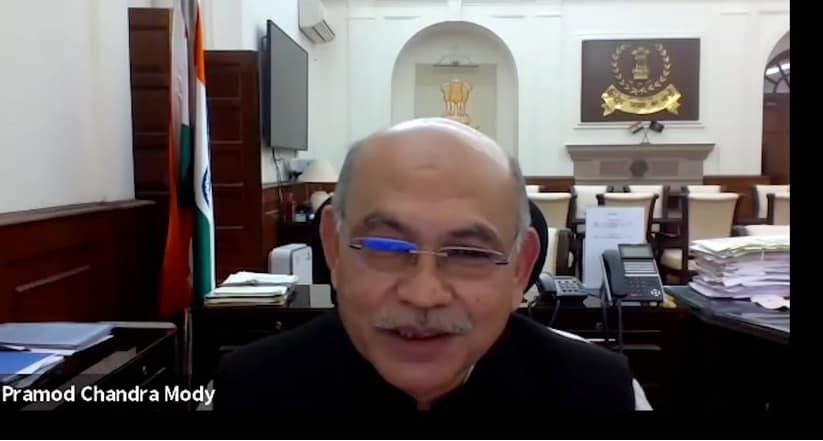Every year, different e-governance thought leaders from different states have set benchmarks by carving out a new path on the road to better governance using technology. At Express Computer, as an independent observer, we have seen the rise and impact of e-governance on the common man. This year too, amidst the pandemic, several thought leaders have used technology innovatively to help citizens have better access to services.
Recognizing the critical role of government thought leaders, Express Computer recently conducted a virtual thought leaders round table, ‘Raising the bar for e-governance’, in partnership with Oracle.
The virtual event was graced by keynote speaker, Pramod Chandra Mody, the Chairman of Central Board Taxes of India, and other thought leaders from different government segments. This included Rama Kamaraju, Senior Consultant, Niti Aayog; Sanjay Mathur, Joint Director, NCRB; Golok Kumar Simli, CTO, Passport Seva; Dr BK Murthy, Senior Director, MeitY and Lily Prasad, Vice President, GeM. Oracle was represented by Debapriya Nandan, Senior Director and Head, Public Sector, Business Development, Oracle India and Vamsicharan Mudiam, Director, Infrastructure Platform Cloud Business Development, Oracle India.

The Chairman also highlighted the facility of pre-filling of income tax returns, which can be utilized by the tax payer for filling up his tax returns quickly and accurately. This makes it possible to electronically verify the ITR filed by him or her. “We are also close to launching the Central Processing Center (CPC) version 2.0, which would enable processing of returns at a super fast speed. We anticipate that now, it would be possible to process the returns and issue the reference, maybe within a week of the filing, which would be a paradigm shift in the manner in which the department is trying to serve the taxpayers.”
The Chairman also spoke about faceless assessment, a game changer in the way the income tax assessment returns are traditionally assessed. Explaining the faceless assessment process, the Chairman said, “We have made a very big change in the assessment process by the launch of what we now call it as the faceless assessment scheme. Now, no longer there would be any sort of territorial jurisdiction. Today, it is a dynamic jurisdiction, which means that a particular taxpayer’s case from say, Delhi could get assessed by any assessing officer from anywhere in India. Sitting from the comfort of his home or office, he can file his return of income, and respond to those notices. And his assessment would be done in a faceless manner. It would also ensure objectivity in the assessment process and enable a fair and judicious assessment of his return. If for some reason there is a dispute between the department and the taxpayer, we have also rolled out another scheme whereby if the taxpayer wishes to appeal against an assessment order, he would be able to file an appeal electronically and his entire appellate process also would be faceless.” Debapriya Nandan, Senior Director and Head, Public Sector, Business Development, Oracle India, thanked the Chairman for his visionary steps, and spoke briefly about the deep relationship that Oracle and the Central Board of Direct Taxes had.
Another highlight of this event was a thought leaders roundtable which was represented by Rama Kamaraju, Senior Consultant, Niti Aayog; Sanjay Mathur, Joint Director, NCRB; Golok Kumar Simli, CTO, Passport Seva; Dr BK Murthy, Senior Director, MeitY and Lily Prasad, Vice President, GeM. Oracle was represented by Debapriya Nandan, Senior Director and Head, Public Sector, Business Development, Oracle India and Vamsicharan Mudiam, Director, Infrastructure Platform Cloud Business Development, Oracle India.

The aspirational districts programme driven by Niti Aayog, has been a landmark initiative, which uses the power of technology to improve the economic development of some of India’s most backward regions.
Rama Kamaraju, Senior Consultant, Niti Aayog, shared with us some of the key highlights of the programme, “We have created a unique platform where we have all the data that are required for performing the required analytics. We even have AI and ML tools embedded within the system. The district administration can look at some of the key socio economic indicators such as health and nutrition education, agriculture, water, financial inclusion, skill development and basic infrastructure. For any decision maker, all the data is available to take a decision or create a strategy for improving the socio economic indicators. Today, all district magistrates involved in this initiative have near real time data. They can create their own visualizations using this data using simple drag and drop tools, and make comparisons. Based on the analysis, they can improve the service delivery to citizens. They are all empowered, and have access to access the data on their mobile phones. This can be very useful when they are on a tour of a certain village, and can take proper decisions at that point of time. So this experience and this particular framework has definitely encouraged many states and today almost around 10 to 12 states apply this particular framework to all the remaining districts in the state. Today, there is a lot of sense of ownership and commitment and accountability in terms of data, data quality, and using real time data for effective planning and implementation.”

One of the key players in the e-governance space in India, Oracle has had a rich history of participating in some of the most landmark e-governance initiatives in the country. Explaining Oracle’s role in the e-governance space, Debapriya Nandan, Senior Director and Head, Public Sector, Business Development, Oracle India, said, “Data is now the important commodity in e-governance. We are closely associated with Niti Aayog in the aspirational districts programme, and we are working with many more state and central government departments. Today, every department relies on analytics, and data is the basic foundation for powering analytics. If you hear Ajay Prakash Sawhney, Secretary, MeitY, he always talks about creating national platforms for areas such as health, logistics, agriculture etc. In all these areas, Oracle has been at the forefront of offering the best secure database. Today, the main issue is ingesting data from the various sources which comes in at a very high speed, storing them, accessing them, and creating reports and trends. For a human being, it is difficult to identify trends and information out of that data in a much more systematic manner. How do you achieve that? How do you get in so much of data coming in at breakneck speed and ensure that it is stored without a single byte getting corrupted? How do you provide real time analytics? At Oracle, we are privileged to be a part in many of the landmark e-governance initiatives using the power of our technology.”
Golok Kumar Simli, CTO, Passport e-Seva, from the Ministry of external affairs, spoke about the importance 
Lily Prasad, Vice President at GeM, spoke about the huge transformation that has been brought about by 

In almost all initiatives, there is a need for a centralized platform, as there are huge number of sources of 
In India, as the panelists shared, huge progress has already been made. But almost all the government departments are not resting on the laurels that they have already got, but they are constantly pushing and raising the bar for e-governance to new levels!
The entire event can be viewed at this link:
https://www.expresscomputer.in/videos/webinars/raising-the-bar-for-e-governance-2/69768/




